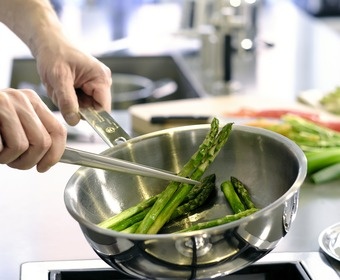Sauté like a pro
- Get the right pan for the job, a sauteuse
- Always uniform size on morsels to be sautéed
- Don’t be afraid of high heat
Too many home kitchens lack a sauteuse. Sauter means ”to jump” in French and refers to this method of cooking where food is tossed around in a pan for a short time under high heat, searing it while at the same time conserving its freshness and crispiness.
This is the same principle as when using an Asian wok. There are a number of requirements to get it right:
You need a sauteuse
A sauteuse is a sturdy frying pan that bears some resemblance to a small wok, the main difference being that the bottom is flat and thick. The flat bottom makes it appropriate for a western stove, the purpose of the thickness is to hold plenty of heat even when food is added.
(The bottom of a wok is thin, but in professional Asian kitchens the heat issue is solved by using gas flames that are extremely hot.)
High heat is a must for sautéing. Therefore there is no real alternative to stainless steel, enamel/ceramics, cast iron (very heavy…), or carbon steel (not a good idea when sautéing acidic ingredients, making sauces, or braising).
High heat essential
This is important. The whole point when sautéing is to heat up the food quickly and to sear it superficially, giving it a flavorful surface layer – what is known as the Maillard effect – without overcooking it.
You need a mise en place
This is kitchen French for, roughly, ”everything in its place”. Sautéing is a technique that is fast and intensive (or you are doing something else…) and it will not leave you time for much else. You will not have time to run to the pantry, therefore all ingredients must be peeled and chopped and within easy reach before you even start. A functional set of bowls is ideal.
You need the right fat
The intensive heat makes the choice of fat important. Most oils will perform better than ordinary butter. Clarified butter (simply melt it gently, let water steam off and remove the milk solids that either float to the top or sink to the bottom) can take a lot more heat. Mixing oil and butter is also a good idea if you want the properties of the oil, but the flavor from the butter.
The fat goes in first and must be hot before you even start.
You need the right “flip and jump”
You’ve seen the pros do it. With an experienced one hand grip they make all the contents of the pan jump, so that everything is seared and cooked evenly. With a sauteuse with the right shape and angles it shouldn’t be hard, but it’s a good idea to practice this technique without an audience in the kitchen.
You need proper kitchen tools
Even if your flip and jump technique (see above) is immaculate, you will still find use for kitchen tweezers and a spatula when handking the ingredients. A wooden spoon can work, but might be a little blunt for the job.
You need even size morsels
Since they are going to jump around in the same hot pan and be evenly seared and cooked through at the same time, you need all morsels of food to be of the same size. If one ingredient needs more time than the others, it has to go in first. Work on your timing.
Sauté with your microwave
A microwave oven can be a good way to “cheat” when sautéing. Some vegetables – broccoli, brussels sprouts, carrots and romano beans are good examples – may need a little longer than you can give them in a hot sauteuse. Try cooking/steaming them in the micro with a splash of water for a minute or two before.
Or steam them in some more complicated way…
Sauté then garnish
It is no secret that excellent produce often benefits from simple preparation. An almost failsafe way to go is to sauté just about any vegetable in oil and garlic. Add a little ordinary salt and top it off with salt flakes, freshly ground pepper, and pleasant things like (roast in a dry pan first) pine nuts, parmesan, a tasty olive oil, a squeeze of lemon, etc.
Sauté like a vegetarian
Sautéing is a technique that makes it easy to be a vegetarian. Just about any vegetable on the planet can be turned into a satisfying dish after a quick session in hot oil, tasty ingredients, salt, and a little garnish.
Only a little food at a time
A sauteuse is suitable for food for only one to two people. If you try to use it for cooking food for a crowd you will never be able to get the heat that you need for intensive, “jump” cooking. The ingredients will all start seeping water and you end up cooking a stew…
Braise with a lid
A sauteuse with a lid is an excellent idea for when you want to braise food, as in boiling it in a smaller amount of liquid like wine or bouillon. What’s more, if you have used it for sauteéing beforehand you still have all the flavors from the ingredients in there.
A carbon steel sauteuse is not suitable for braising since the liquid – especially if acidic – can oxidise the steel and pick up metallic (but harmless) flavors.



